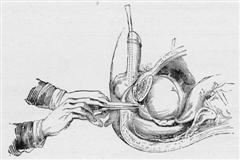Virtual Museum
Cutting for the Stone
As used by Frère Jacques
 This procedure appears to have been introduced by the French itinerant stone cutter Jacques de Beaulieu (or Frère Jacques).
This procedure appears to have been introduced by the French itinerant stone cutter Jacques de Beaulieu (or Frère Jacques).
A solid staff (sound) with no groove was first introduced through the urethra. An incision was made with a long knife or bistoury, medial to the left ischial tuberosity passing obliquely upwards and cutting everything which came in the way between the tuberosity and the staff. After the stone had been felt by a finger in the wound, a dilator or conductor was passed into the bladder, followed by forceps with which the stone was pulled out. The incision passes between the erector muscle (ischiocavernosus) and the accelerator urinae (bulbocavernosus) and then through the prostate and whole length of the neck of the bladder and about half an inch into the bladder itself.
The mortality was high due to haemorrhage, bladder and bowel injury. Fistulae were common. Frère Jacques improved his operation after studying some anatomy from John Rau in Amsterdam and Fagon in Versailles. Using a grooved staff and small blade instead of cutting the posterior wall of the bladder, he divided the prostate and bladder neck onto the grooved staff with less danger of damaging the pudendal artery and rectum. He cut 38 successive patients in Versailles without death.
Both John Jacob Rau and William Cheselden studied Frère Jacques method and, using their superior anatomical knowledge, were very sucessful with it.
← Back to Cutting for the Stone